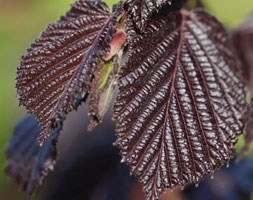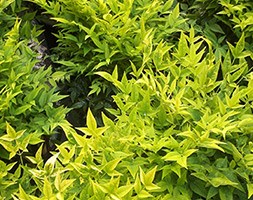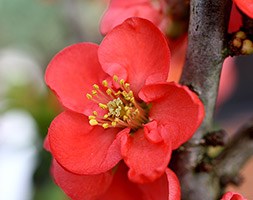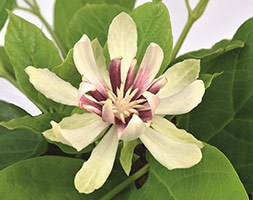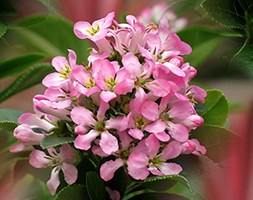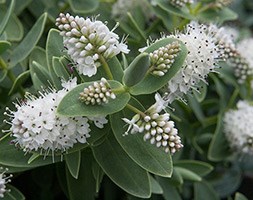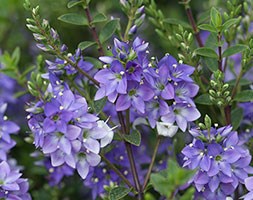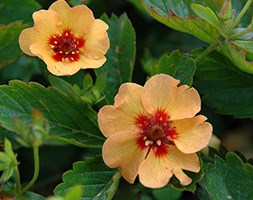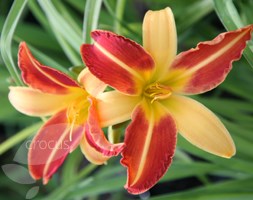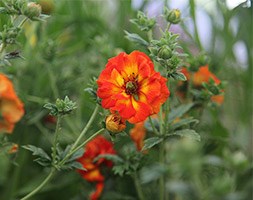New products at Crocus
by Sarah - July 4th, 2014.Filed under: Crocus, New Products.
Crocus just added these new items
Corylus maxima ‘Purpurea’ (filbert) £39.99
Position: full sun Soil: fertile, well-drained, preferably chalky soil Rate of growth: average Flowering period: February to March Flower colour: purple catkins Other features: edible nuts Hardiness: fully hardy Purple-tinged catkins appear in late winter, and are followed by edible nuts, which ripen in mid-August. The heart-shaped leaves emerge a rich purple, then turn a deep green as they mature. This upright filbert makes an excellent specimen tree for a small, sunny garden. The tree’s common name is derived from the edible nuts that ripen about the time of St. Philibert’s Day (20 August). Garden care: Prune dead, diseased and damaged wood in March and apply a 5-7cm (2-3in) mulch of well-rotted organic matter around the base of the plant.
Nandina domestica ‘Lemon and Lime (PBR)’ (heavenly bamboo) £19.99
Position: full sun or partial shade Soil: moist but well-drained soil Rate of growth: average Flowering period: July Hardiness: frost hardy (needs winter protection in cold areas) Garden care: In mid or late spring lightly cut back any shoots that spoil the symmetry of the plant.
Chaenomeles ‘Red Kimono’ (flowering quince) £19.99
Position: full sun or partial shade Soil: moderately fertile, well-drained soil Rate of growth: fast-growing Flowering period: March to May Hardiness: fully hardy Garden care: After flowering prune side shoots to five or six leaves and remove crossing or ill-placed stems. Once established remove excess growth in late spring or summer and cut back all side shoots to two or three leaves.
x Sinocalycalycanthus ‘Venus’ (Carolina allspice) £19.99
Position: full sun Soil: moderately fertile, humus-rich, moist but well-drained soil Rate of growth: average Flowering period: May to September Hardiness: fully hardy Garden care: Shelter from cold drying winds. Remove dead or damages stems in late winter or early spring.
Escallonia ‘Pink Elle’ (PBR) (escallonia) £12.99
Position: full sun Soil: fertile, well-drained soil Rate of growth: average Flowering period: June to September Hardiness: frost hardy (needs winter protection in cold areas) Garden care: Deadhead regularly to prolong flowering. In mid or late spring lightly cut back any shoots that spoil the symmetry of the plant. After pruning apply a generous 5-7 cm (2-3in) mulch of well- rotted garden compost or manure around the base of the plant.
Hebe albicans (white hebe) £9.99
Clusters of pretty white flowers in early and midsummer and grey-green leaves retained throughout the year. This dense, compact shrub is excellent for a protected border in sun or partial shade. It’s an ideal plant for urban or coastal gardens since it tolerates a certain amount of pollution and salt-laden air. Position: full sun or partial shade Soil: poor or moderately fertile, moist, well drained neutral to slightly alkaline soil Rate of growth: average Flowering period: June and July Flower colour: white Other features: grey-green coloured leaves Hardiness: frost hardy Garden care: Needs minimal pruning. Remove misplaced or frost damaged branches in late spring.
Hebe ‘Youngii’ (syn hebe Carl Teschner) £9.99
Position: full sun or partial shade Soil: moist, well drained and fertile Flowering period: June – August Hardiness: frost hardy (will need protection in colder winters) Garden care: Needs minimal pruning. Remove misplaced or frost damaged branches in late spring. Protect from severe winter weather.
Potentilla x tonguei (cinquefoil) £4.99
Position: full sun Soil: poor to moderately fertile, well-drained soil Rate of growth: average Flowering period: June to August Hardiness: fully hardy Garden care: Lift and divide large clumps in autumn or spring. In spring apply a generous 5-7cm (2-3in) mulch of well-rotted garden compost or manure around the base of the plants
Hemerocallis ‘Frans Hals’ (daylily) £4.99
Position: full sun Soil: fertile, moist, well-drained soil Rate of growth: average Flowering period: July Hardiness: fully hardy An unusual daylily, with masses of rust-red and orange bi-coloured flowers appea ring continuously in midsummer. Each flower has three dusty-orange outer petals and three bronze inner petals with a prominent yellow midrib. This plant looks fabulous planted in drifts in a sunny mixed or herbaceous border among ‘hot’ colours, or with cannas and montbretias as companions. The bright green, strap -like leaves are evergreen in mild areas, and soon form large clumps of strap-li ke foliage that helps to suppress weeds. Like most hemerocallis, it is robust and easy to grow, provided you follow the tips below. Garden care: The Greek term ‘hemerocallis’ means ‘beautiful for a day’, and daylilies need regular deadheading to prolong flowering and prevent their unsightly deadheads from dominating the scene. Each stem carries several flowers, so snap off each flower as it fades. When the stem has finished flow ering, cut it down to the ground. After the plant has finished flowering altoge ther, pull out the dead leaves. When the foliage is looking tatty, cut it down to the ground and fresh new growth will appear. Lift and divide every three years in spring to keep the rhizomes vigorous and apply a generous 5-7cm (2-3in) mulch of well-rotted garden compost or manure around the base of the plant. Water frequently from spring until the buds appear.
Potentilla ‘William Rollison’ (cinquefoil) £4.99
Position: full sun Soil: poor to moderately fertile, well-drained soil Rate of growth: average Flowering period: June to August Hardiness: fully hardy Garden care: Lift and divide large clumps in autumn or spring. In spring apply a generous 5-7cm (2-3in) mulch of well-rotted garden compost or manure around the base of the plants







